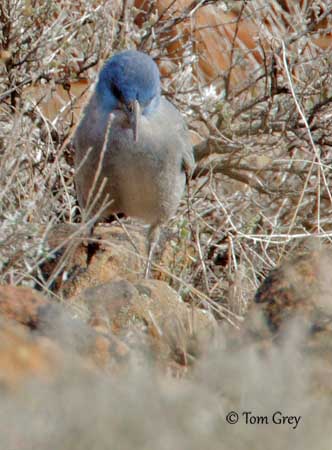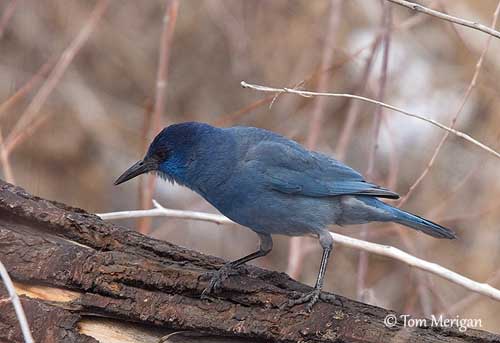
Fr: Geai des pinèdes
All : Nacktschnabelhäher
Esp : Chara Piñonera
Ital : Ghiandaia dei pini
Nd: Pinyongaai
Sd: Tallskrika
Photographers:
Tom Grey
Tom Grey's Bird Pictures
Tom Merigan
Tom Merigan’s Photo Galleries
Text by Nicole Bouglouan
Sources:
HANDBOOK OF THE BIRDS OF THE WORLD Vol 14 by Josep del Hoyo-Andrew Elliot-David Christie - Lynx Edicions – ISBN: 9788496553507
BIRDS OF THE GREAT BASIN – by Fred A. Ryser - Univ of Nevada Pr -ISBN: 0874170796
BirdLife International (BirdLife International)
All About Birds (Cornell Lab of Ornithology)
Pinyon Jay
Gymnorhinus cyanocephalus
Passeriforme Order – Corvidae Family
BIOMETRICS:
Length: 26-29 cm
Weight: 99-111 g
DESCRIPTION:
The Pinyon Jay is a gregarious bird living in flocks all year round. This vulnerable species is especially threatened by forest fragmentation and habitat loss.
The adult male has dull blue plumage overall, with different blue shades according to the light.
On the upperparts, the male is more greyish-blue, with greyer flight feathers. The primaries show black inner webs. The tail is relatively short.
On the underparts, the blue colour is slightly paler. Chin and throat are whitish and slightly mottled dark grey.
The head is brighter blue. The eyes are dark brown. Bill, legs and feet are black.

The female looks similar but she is smaller and has shorter bill. On the head, crown and cheeks are usually duller and paler blue.
The juvenile is dull grey with blue-grey wings and rectrices.
The immature resembles female but it is often duller, with brown inner webs of primaries.
VOICE: SOUNDS BY XENO-CANTO
The Pinyon Jay has wide repertoire of several different calls, with the most typical, a high-pitched, nasal “caw”.
This large variety of sounds is used among the social groups, allowing individual recognition of parents and young, mates and group-members.
The alarm call is a rattle sound rising in pitch and frequency, according to the threat “krawk-kraw-krawk”. It can be a combination of several calls such as “near-er”, “racka” and “chirr”.
The females give rattles and trills. The begging-call of females and juveniles is a “chirr” note. The male utters a nasal “ran” in response to the female.
The “rambling” song is very long, up to 20 minutes or more. It is often given by isolated birds.
HABITAT:
The Pinyon Jay is found on foothills and dry mountain slopes near woodlands and forest where pinyon-juniper (Pinus – Juniperus), sagebrush (Artemisia), scrub-oak (Quercus) and chaparral are present.
It also inhabits areas with Pinus ponderosa and Pinus jeffreyi. It can be seen in gardens in urban areas.
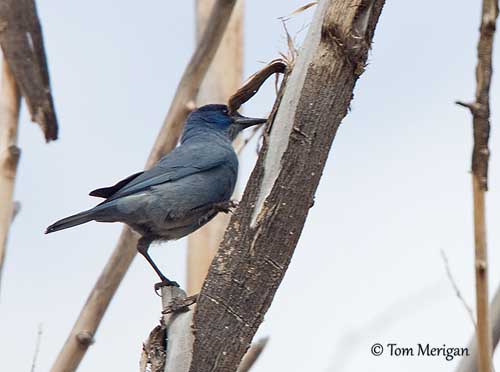
RANGE:
The Pinyon Jay occurs through the Great Basin and West Central United States, from Oregon, S along the slopes of dry mountains of E California to extreme NW Mexico (Baja California), E to Montana and South Dakota, Wyoming, W Nebraska, W Oklahoma and New Mexico.
BEHAVIOUR:
The Pinyon Jay is omnivorous but it takes pine seeds almost all the year. It harvests pinyon-pine seeds in late summer and fall, and carries them to communal “caching areas”. These seeds are stored in the ground as food resources during winter and spring. Numerous seeds will germinate to produce new pine trees.
But the Pinyon Jay also eats numerous arthropods, grasshoppers, spiders, beetles, flies and small lizards.
It forages in pine trees and harvests thousands of seeds. It also frequents the bird-feeders in urban gardens. It feeds on the ground too, taking several animal items.
These birds often forage in flocks by walking and flying through woodlands. They live in large flocks of up to 500 birds all year round. While feeding, several birds play the role of sentinels and survey the surroundings, in order to protect the group.
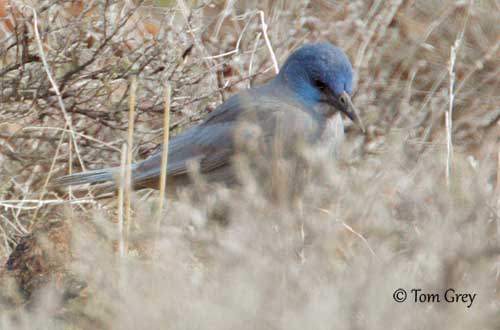
Although living in loose flocks in winter, the adults appear to remain pair-bonded all year round. The flock lives in a home-range area and does not migrate.
However, these birds perform foraging movements, especially when the pine seeds become scarce. They disperse and are nomadic while searching for food.
But usually, their home-range is fairly stable. During the nest-building, they roost together at night and feed in flock by day.
The courtships occur in winter and early spring, as well between mates of an established pair, as between younger birds.
Several observations of silent courtship feeding involving both adults and first year birds were made by mid-November. This behaviour is used to strengthen and stimulate the pair-bonds between mates, but also to initiate pair-bonding between young jays.
Some weeks later, by mid-December, in addition to courtship feeding, the females are seen chasing the males and begging for food much stronger while fluttering vigorously the partly open wings.
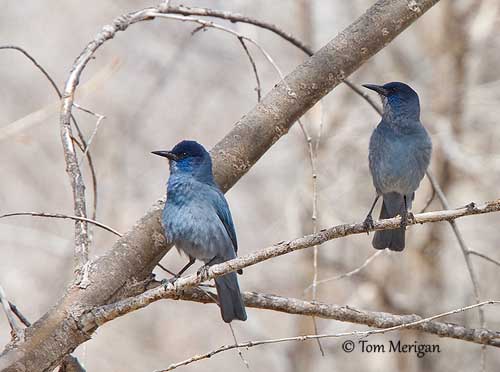
By January and early February, chases involving up to 12 birds are observed. Low “click” are often given during these flights.
Then, the pair moves away from the flock, and the mates feed together or feed each other, and the male offers twigs and grasses to the female.
The Pinyon Jays nest in loose colonies and the flock usually returns to the same nesting area year after year.
FLIGHT:
The Pinyon Jay flies rapidly through and above the trees during the flight displays. The flock performs sharp turns and steep dives.
This species has 11 secondary flight feathers instead of 10, which is the pattern of the New World jays.
REPRODUCTION:
The breeding season starts by mid-February, and the Pinyon Jay may breed in autumn too if there are available food resources.
This species forms monogamous permanent pair-bonds. They nest colonially and co-operative breeding is regular but at low frequency. The helpers may benefit from more parental care, but the breeding success does not increase.
Both sexes build the nest, usually in the upper half of juniper or pine trees. There is an outer platform made with sticks, with a middle layer of woven grasses, and the thick inner cup is lined with plant parts, feathers, horse hair and debris.
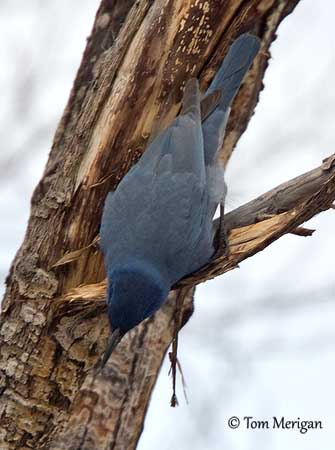
The female lays 2-5 eggs and incubates during 17 days. The chicks are fed by both adults and fledge about 3 weeks after hatching.
The juveniles gather in crèches and are guarded all the day while the adults forage in flocks. The young are still fed by their parents and depend on them for 2-3 months more.
The nest-failures are due to hard snowstorms and nest-predation by mammals, birds and reptiles. Usually, the pair nests again in a new site.
DIET:
The Pinyon Jay feeds mainly on seeds from pine trees, but it also takes various insects, spiders and small lizards.
PROTECTION / THREATS / STATUS:
The populations of the Pinyon Jay suffered decline throughout the range, due to habitat loss with degradation of the pinyon-juniper woodland habitat for pasture and cattle expansion.
This species is considered as Vulnerable by Birdlife International.
